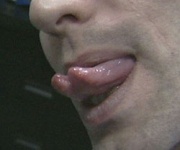Tongue split
The tongue splitting procedure is the central bifurcation of the tongue, so as to achieve a "forked tongue." With practice, each half can be separately controlled.
Contents
- Placement
- Procedure
- Healing and aftercare
- Long-term health issues
- History
- Reversal
- Legality
- Related risks
- External links
Placement
The median fibrous septum that centrally divides the tongue is cut, separating the two lateral halves of the tongue. Done carefully, very little damage should be done in the process.
It is not a good idea to cut the tongue in more than two pieces. To do so would risk cutting into the lingual nerves, the lingual glands, numerous major blood vessels, and it is dubious whether full nervous control could be sustained even if done by an oral surgeon. Attempting a "trifuraction" (or more) would almost certainly end in disaster.
Procedure
Tongue splitting can be accomplished by one or more of the following methods:
Oral surgery
The most recommended method is to seek an oral surgeon. Any oral surgeon who uses a laser should be able to bifurcate a tongue with ease, providing their ethics allow it. A doctor will normally charge between $500 and $3000 for this procedure. After applying anesthesia, using a laser, the practitioner will first create a guideline along the top and bottom of the tongue. Then, they'll slowly cut through the tissue until the tongue is fully bifurcated, cauterizing the wound as they cut. This is usually, at most, a fifteen-minute process. In general, there is little to no blood during this stage. The only bleeding tends to be during suturing.
Laser procedures usually take 1-2 weeks for primary healing, and a month for the healing to be complete.
Tie-off
Tie-off is another method. This gradual method, allows one time adjust, but may also mean weeks of extreme discomfort. This procedure is usually self-done, and a majority of people who undertake this method give up partway through. It requires a high degree of pain tolerance over an extended time. The glands in and around the tongue tend to swell; therefore, speech and eating are usually affected during this process. Many people opt to "snip" through the last part of the tongue using a blade.
Scalpelling
Scalpelling involves the straightforward splitting of the tongue down the middle using a blade. This is generally very bloody, and this bleeding can be difficult to control. Many practitioners choose to use cauterization, either from electric cauterizing pens or traditional branding tools, on large blood vessels. Others use chemical or herbal means to control bleeding and/or to assist in healing.
Cauterizing
Cauterizing is similar to a scalpelled tongue splitting, but a heated blade or tool is used to burn the split through the tongue, hopefully (and generally successfully), cauterizing the tongue in the process, almost totally eliminating bleeding. This technique does carry a greater risk of peripheral damage and may be outrageously painful.
Suturing
Suturing pulls the top skin of the tongue down into the split, leaving a more "natural" and rounded appearance that many people prefer. While similar healing often occurs without suturing, in other cases a non-sutured tongue may heal with a somewhat "flat" inside that looks artificial rather than natural.
Risks
Assuming the procedure is done by a doctor, the risks are negligible, and complications that arise in a controlled medical environment can typically be dealt with easily. Doctors will provide you with paperwork explaining the secondary risks, such as reactions to anesthesia.
Loss of blood, damage to nerves and glands in the tongue are also possible, although unlikely if the split is not extremely deep and remains centered. Infection and scarring are certainly possible as well, but they are very rare.
Healing and aftercare
Primary healing (where you can talk and eat relatively normally) takes between one and two weeks, and full healing is usually complete within one month. Regrowth is quite common. The re-growth occurs during the initial healing and continues over the first year or so. Short of re-cutting, there's not a lot that can be done to stop that.
Long-term health issues
Initial bleeding and infection can be a risk, especially with home-jobs. In a worst-case situation, the tongue can swell and block the airway, although this has not been documented. As far as long-term risk, there may be minor changes in some speech sounds, but this rarely happens, and effects are extremely minor at most. Tongue splitting does not appear to have any side effects with regards to eating.
History
Tongue splitting, to some, a pinnacle of "Khechari Mudra" practices, is a part of Hatha and Kumbhaka yoga where the tongue is split and then "milked" until it is long enough to be turned back inside the mouth and flipped up to the epiglottis. It then is used in breathing exercises, the goal being to seal the body's energy leaks and to become aware of only the internal.
Recently, starting in 1997, tongue splitting became very popular in the West. The Lizardman and Shannon Larratt with their promotion of the modification started the snowball rolling. Since about 2000, tongue splitting has been one of the most popular, common, safe, and highest long-term satisfaction extreme modifications out there.
Reversal
By removing the skin on the inside of the split and then suturing the tongue back together, it can be induced to "go back to normal." Tongue splitting reversal is strongly discouraged—don't split your tongue if you think you might have to reverse it in the future.
Legality
Tongue splitting is generally legal for oral surgeons to perform, although the vast majority of surgeons will refuse to do it either for personal reasons or for fear of professional backlash.
Performing a tongue splitting on yourself is generally legal, although in many jurisdictions it could be used to facilitate a psychiatric examination and possible commitment, especially if complications occur.
